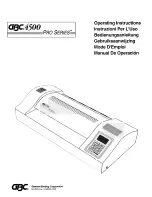
Safety
F - 160 Operation and Maintenance Manual
© GBC Pro - Tech August 1999
Page 1 - 2
GBC Pro - Tech laminators are powerful
machines that are designed to mount, laminate, and
encapsulate. The forces required to accomplish these
tasks can vary from negligible to very large.
The motorized main roll lift mechanism used to
provide downward pressure on the top roll is capable
of producing forces greater than 400
pounds. This force
is applied to any object presented in the opening (
called the nip ) between the two rolls.
Use care in lowering the top laminating roll and
know how to react quickly in an emergency. The main
laminator roll up / down control is located on the right
side of the machine within the front control panel. The
GAP up / down arrows controls the motion of the top
main laminating roll. Before pressing the GAP down
arrow, ensure that nothing is in the nip area.
In addition, the main laminating rolls of the F-
160 can reach temperatures of over 200
o
F
( 100
o
C ).
D A N G E R
At these temperatures there is a danger of
severe burn if the rolls are touched during
setup, operation or servicing.
INFORMATION
Only a qualified service technician should
perform any procedure in Part B of this
manual.
The word qualified is defined below;
Qualified ;
• Any engineer that has experience with
electrical and mechanical design of lamination
equipment.The engineers should be fully aware of all
aspects of safety with regards to lamination equipment.
• Any commissioning or service engineer must
be of competent nature, trained and qualified to GBC
Pro-Tech standards to fulfill that job. This person will
have completed and passed the full service training
course from GBC Pro-Tech.
• Any GBC Technician, GBC Specialist, and /
or GBC Pro-Tech Technician that has been through the
GBC Pro-Tech service training course.
The F-160 laminator has steel cabinets and leg
panels that are bolted close to isolate the electrical and
drive system components for the safety of the operator.
Figure 1.2.1 illustrates placement of the cabinets and
covers.
Figure 1.2.1 Cabinets and covers
Plane4
Plane4
Cabinets
C o v e r s













































